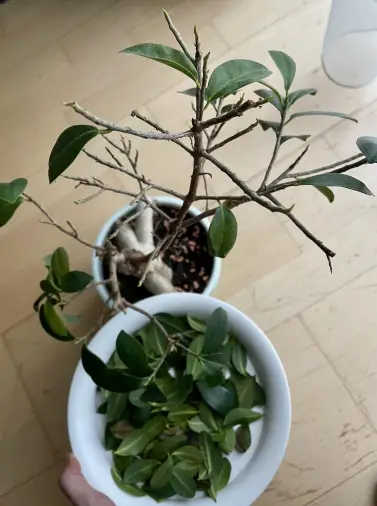Your bonsai may be losing leaves due to improper watering or inadequate light. Stress from environmental changes can also cause leaf drop.
Bonsai trees are delicate and require specific care to thrive. Watering incorrectly—either too much or too little—can lead to leaf loss. Ensure your bonsai gets enough light, as insufficient light can weaken the tree and cause leaves to fall. Environmental stress, such as sudden temperature changes or drafts, can also affect your bonsai’s health.
Why is My Bonsai Losing Leaves: Identifying the exact cause of leaf drop is crucial for effective treatment. Regularly inspect your bonsai for signs of pests or diseases, which can also contribute to leaf loss. Proper care and attention to your bonsai’s needs will help maintain its health and beauty.
Table of Contents
The Mystique Of Bonsai Trees
Bonsai trees hold a special place in many cultures. They represent harmony, balance, and patience. People often admire their beauty and the artistic effort needed to grow them. These tiny trees are seen as a symbol of peace and tranquility. For centuries, they have been cultivated to create a miniature version of nature. Many people find a sense of calm and relaxation when caring for their bonsai.
Growing a bonsai tree is both an art and a science. It requires careful pruning and training. The goal is to create a tree that looks natural yet artistic. Bonsai enthusiasts use wires and special tools to shape the branches. The tree must be watered and fed regularly. Light and temperature also play a key role in its health and growth. The process is ongoing and requires dedication. Each tree is unique and tells its own story.
Why is My Bonsai Losing Leaves: Common Causes Of Leaf Loss In Bonsai
Overwatering can drown the roots. This leads to leaf loss. Underwatering makes the soil too dry. Roots can’t absorb enough water. Both conditions stress the plant. Stress causes leaves to fall off. Always check the soil moisture. Water when it feels dry.
Too much light can burn the leaves. Burnt leaves drop off. Too little light causes weak growth. Weak leaves fall easily. Place your bonsai in a spot with bright, indirect light. Make sure it gets enough light daily.
Seasonal Changes Impacting Bonsai
Seasonal changes can cause your bonsai to lose leaves. Temperature shifts and varying light conditions affect its growth. Proper care during transitions helps maintain leaf retention.
Winter Dormancy
Bonsai trees experience winter dormancy. This is a natural process. Trees rest during cold months. Leaf loss happens during this time. Energy is conserved for growth in warmer seasons. Keep your bonsai in a cool place. Avoid freezing temperatures. Water less during winter dormancy. Leaves will return in spring.
Spring Renewal
Spring brings renewal for bonsai trees. New leaves start to grow. Warm weather helps the tree wake up. Water your bonsai more often. Use fertilizer to boost growth. Prune dead branches to help new growth. Enjoy the fresh green leaves. Your bonsai will look healthy again.

Credit: www.reddit.com
Pest Infestations And Diseases
Aphids are tiny, green, and sap-sucking insects. They cause leaves to curl. Spider mites are red or black and create webs. They suck out plant juices. Scale insects appear as small, brown bumps. They weaken the plant by feeding on sap. Caterpillars chew on leaves, leaving holes. Mealybugs look like tiny cotton balls. They hide in leaf joints and suck sap.
Keep your bonsai clean by removing dead leaves. Inspect it regularly for signs of pests or disease. Water properly to avoid root rot. Use well-draining soil to prevent fungal growth. Prune infected branches to stop the spread of disease. Apply insecticidal soap to control pests. Use fungicides to treat fungal infections. Quarantine new plants to avoid spreading diseases.
Nutritional Deficiencies And Soil Issues
Fertilizers provide essential nutrients to your bonsai. Nutrient deficiencies can cause leaf loss. Nitrogen, phosphorus, and potassium are vital for growth. Lack of these nutrients weakens the plant. Use balanced fertilizers to ensure healthy leaves. Organic fertilizers can also be beneficial. Too much fertilizer can harm the bonsai. Always follow the recommended dose.
Good soil is crucial for bonsai health. Poor soil quality can lead to leaf loss. Soil must drain well to prevent root rot. Mixing sand, clay, and organic matter can improve soil. Soil pH should be suitable for the bonsai species. Regular soil checks help maintain health. Re-potting the bonsai can refresh the soil. Always use high-quality soil for best results.

Credit: www.plantsforallseasons.co.uk
Environmental Stress Factors
Bonsai trees are sensitive to temperature changes. Sudden temperature drops can cause leaf loss. Extreme heat can also stress the tree. Bonsai trees prefer stable temperatures. Keep them away from drafty windows and heaters.
Low humidity can dry out bonsai leaves. High humidity can lead to mold growth. Bonsai trees thrive in balanced humidity. Use a humidity tray to maintain proper levels. Regular misting can also help.
Improper Pruning Techniques
Pruning helps your bonsai grow well. Always use clean and sharp tools. Cut branches at an angle. Never cut too close to the trunk. This may harm the tree. Don’t prune more than 25% of the tree at once. Over-pruning can stress your bonsai. Avoid pruning when the tree is weak or sick. This can make it worse.
Trim your bonsai during the growing season. This is usually in spring and early summer. Don’t prune in late autumn or winter. The tree needs time to heal before the cold. Trim new growth regularly. This keeps your bonsai in shape. Avoid trimming just before or during flowering. This can affect the blooms.
Recovery And Rehabilitation Of A Bonsai
Stressed bonsai trees often lose leaves. This can be due to overwatering or underwatering. Ensure the soil is moist but not soggy. Check for pests and remove them gently. Place the bonsai in a location with indirect sunlight. Avoid sudden temperature changes. Prune dead leaves to encourage new growth. Repotting may be necessary if roots are bound. Use well-draining soil to prevent root rot. Monitor the tree daily for any changes.
Consistent care is key for a healthy bonsai. Water the tree regularly but do not overwater. Fertilize during the growing season with balanced nutrients. Trim the branches to shape the tree and remove dead parts. Ensure the bonsai gets adequate light. Rotate the tree periodically for even growth. Check for pests and diseases regularly. Repot the bonsai every 2-3 years to maintain healthy roots. Use wire to train the branches carefully.
Choosing The Right Bonsai For Your Environment
Indoor bonsai like Ficus and Jade are best for inside the house. They need less sunlight. Outdoor bonsai such as Juniper and Pine need more sunlight. They grow better outside.
| Species | Indoor or Outdoor | Special Care |
|---|---|---|
| Ficus | Indoor | Low sunlight |
| Jade | Indoor | Water sparingly |
| Juniper | Outdoor | Full sunlight |
| Pine | Outdoor | Well-drained soil |
Credit: gardening.stackexchange.com
Expert Tips For Bonsai Maintenance
Water your bonsai regularly. Use a gentle spray to keep the soil moist. Avoid overwatering to prevent root rot. Check for pests like aphids and mites. Use a natural pesticide if needed. Prune your bonsai to keep it healthy. Remove dead or yellow leaves. Provide enough sunlight for at least 6 hours daily. Rotate the pot to ensure even growth. Fertilize the soil every month using a balanced fertilizer. Clean the leaves to remove dust and dirt. This helps the bonsai breathe better.
Repot your bonsai every 2-3 years. Use fresh soil to encourage growth. Wire the branches to shape them. Be gentle to avoid damage. Use bonsai tools like shears and concave cutters. These tools help in precise pruning. Monitor humidity levels to keep the bonsai healthy. Use a humidity tray if needed. Apply moss to the soil surface. It helps retain moisture. Graft branches to add new growth. This technique is for experienced growers.
Frequently Asked Questions
Why Have The Leaves Falling Off My Bonsai Tree?
Leaves fall off Bonsai trees due to overwatering, underwatering, insufficient light, or sudden temperature changes. Check soil moisture, light exposure, and temperature.
What Does An Overwatered Bonsai Tree Look Like?
An overwatered Bonsai tree shows yellowing leaves, soft trunk, and root rot. The soil remains consistently wet.
How Often Should A Bonsai Tree Be Watered?
Water a Bonsai tree when the soil feels slightly dry. Typically, this is every 2-3 days. Adjust based on climate and season.
Will My Bonsai Tree Leaves Grow Back?
Yes, Bonsai tree leaves can grow back. Ensure proper care, watering, and sunlight. Healthy trees typically recover well.
Conclusion
Caring for a bonsai requires attention to detail. Leaf loss can signal underlying issues. Ensure proper watering, sunlight, and soil conditions. Regularly inspect for pests and diseases. With the right care, your bonsai will thrive and flourish. Remember, patience and diligence are key to a healthy bonsai.
